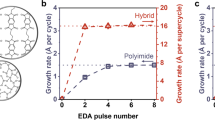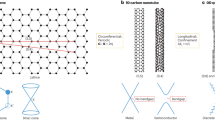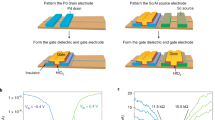Abstract
Carbon-nanotube-based electronics offers significant potential as a nanoscale alternative to silicon-based devices for molecular electronics technologies. Here, we show evidence for a dramatic electrical switching behaviour in a Y-junction carbon-nanotube1,2,3 morphology. We observe an abrupt modulation of the current from an on- to an off-state, presumably mediated by defects and the topology of the junction. The mutual interaction of the electron currents4 in the three branches of the Y-junction is shown to be the basis for a potentially new logic device. This is the first time that such switching and logic functionalities have been experimentally demonstrated in Y-junction nanotubes without the need for an external gate. A class of nanoelectronic architecture and functionality, which extends well beyond conventional field-effect transistor technologies5,6, is now possible.
This is a preview of subscription content, access via your institution
Access options
Subscribe to this journal
Receive 12 print issues and online access
$259.00 per year
only $21.58 per issue
Buy this article
- Purchase on Springer Link
- Instant access to full article PDF
Prices may be subject to local taxes which are calculated during checkout





Similar content being viewed by others
References
Zhou, D. & Seraphin, S. Complex branching phenomena in the growth of carbon nanotubes. Chem. Phys. Lett. 238, 286–289 (1995).
Li, W. Z., Wen, J. G. & Ren, Z. F. Straight carbon nanotube Y junctions. Appl. Phys. Lett. 79, 1879–1881 (2001).
Satishkumar, B. C., Thomas, P. J., Govindaraj, A. & Rao, C. N. R. Y-junction carbon nanotubes. Appl. Phys. Lett. 77, 2530–2532 (2000).
Xu, H. Q. Electrical properties of three-terminal ballistic junctions. Appl. Phys. Lett. 78, 2064–2066 (2001).
Xu, H. Q. et al. Novel nanoelectronic triodes and logic devices with TBJs. IEEE Electron Dev. Lett. 25, 164–166 (2004).
Baughman, R. H., Zakhidov, A. A. & de Heer, W. A. Carbon nanotubes-the route toward applications. Science 297, 787–792 (2002).
Saito, R., Dresselhaus, G. & Dresselhaus, M. S. Physical Properties of Carbon Nanotubes (Imperial College Press, London, 1998).
Forro, L. & Schonenberger, C. in Carbon Nanotubes-Topics in Applied Physics (ed. Avouris, P.) (Springer, Heidelberg, 2001).
Kim, P., Shi, L., Majumdar, A. & McEuen, P. L. Thermal transport measurements of individual multiwalled nanotubes. Phys. Rev. Lett. 87, 215502 (2001).
Collins, P. G., Hersam, M., Arnold, M., Martel, R. & Avouris, P. Current saturation and electrical breakdown in mutiwalled carbon nanotubes. Phys. Rev. Lett. 86, 3128–3131 (2001).
Martel, R., Schmidt, T., Shea, H. R., Hertel, T. & Avouris, P. Single- and multi-wall carbon nanotube field-effect transistors. Appl. Phys. Lett. 73, 2447–2449 (1998).
Tans, S. J., Verschueren, A. R. M. & Dekker, C. Room-temperature transistor based on a single carbon nanotube. Nature 393, 49–52 (1998).
Javey, A., Guo, J., Wang, Q., Lundstrom, M. & Dai, H. Ballistic carbon nanotube field-effect transistors. Nature 424, 654–657 (2003).
Postma, H. W. C., Teepen, T., Yao, Z., Grifoni, M. & Dekker, C. Carbon nanotube single-electron transistors at room temperature. Science 293, 76–79 (2001).
Gothard, N. et al. Controlled growth of Y-junction nanotubes using Ti-doped vapor catalyst. Nano Lett. 4, 213–217 (2004).
Shorubalko, I., Xu, H. Q., Omling, P. & Samuelson, L. Tunable nonlinear current-voltage characteristics of three-terminal ballistic nanojunctions. Appl. Phys. Lett. 83, 2369–2371 (2003).
Shorubalko, I. et al. A novel frequency-multiplication device based on three-terminal ballistic junction. IEEE Electron Dev. Lett. 23, 377–379 (2002).
Song, A. M. et al. Nonlinear electron transport in an asymmetric microjunction: A ballistic rectifier. Phys. Rev. Lett. 80, 3831–3834 (1998).
Palm, T. & Thylen, L. Designing logic functions using an electron waveguide Y-branch switch. J. Appl. Phys. 79, 8076–8081 (1996).
Andriotis, A. N., Menon, M., Srivastava, D. & Chernozatonski, L. Transport properties of single-wall carbon nanotube Y-junctions. Phys. Rev. B 65, 165416 (2002).
Csontos, D. & Xu, H. Q. Quantum effects in the transport properties of nanoelectronic three-terminal Y-junction devices. Phys. Rev. B 67, 235322 (2003).
Andriotis, A. N., Srivastava, D. & Menon, M. Comment on “Intrinsic electron transport properties of carbon nanotube Y-junctions”. Appl. Phys. Lett. 83, 1674–1675 (2003).
Tian, W. et al. Conductance spectra of molecular wires. J. Chem. Phys. 109, 2874–2882 (1998).
Heinze, S. et al. Carbon nanotubes as Schottky barrier transistors. Phys. Rev. Lett. 89, 106801 (2002).
Crespi, V. H., Chopra, N. G., Cohen, M. L., Zettl, A. & Louie, S. G. Anisotropic electron-beam damage and the collapse of carbon nanotubes. Phys. Rev. B 54, 5927–5931 (1996).
Banhart, F. Irradiation effects in carbon nanostructures. Rep. Prog. Phys. 62, 1181–1221 (1999).
Gopal, V. et al. Rapid prototyping of site-specific nanocontacts by electron and ion beam assisted direct-write nanolithography. Nano Lett. 4, 2059–2063 (2004).
Bachtold, A. et al. Contacting carbon nanotubes selectively with low-ohmic contacts for four-probe electric measurements. Appl. Phys. Lett. 73, 274–276 (1998).
Andriotis, A. N., Menon, M., Srivastava, D. & Chernozatonski, L. Rectification properties of carbon nanotube “Y-junctions”. Phys. Rev. Lett. 87, 066802 (2001).
Papadapoulos, C., Rakitin, A., Li, J., Vedeneev, A. S. & Xu, J. M. Electronic transport in Y-junction carbon nanotubes. Phys. Rev. Lett. 85, 3476–3479 (2000).
Acknowledgements
P.R.B. acknowledges useful discussions with M. Di Ventra and J. Lagerkvist. We also thank graduate students N. Gothard and J. Gaillard for synthesizing the Y-junction nanotubes, and P. Yu who set up the LabView programs for data acquisition. We acknowledge the support of the work by NSF-NIRTs under Grant numbers DMI-0210559, DMI-0303790, DMI-0304019 and University of California Discovery Fund under Grant No. ele02-10133/Jin.
Author information
Authors and Affiliations
Corresponding author
Ethics declarations
Competing interests
The authors declare no competing financial interests.
Rights and permissions
About this article
Cite this article
Bandaru, P., Daraio, C., Jin, S. et al. Novel electrical switching behaviour and logic in carbon nanotube Y-junctions. Nature Mater 4, 663–666 (2005). https://doi.org/10.1038/nmat1450
Received:
Revised:
Accepted:
Published:
Issue Date:
DOI: https://doi.org/10.1038/nmat1450
This article is cited by
-
Synthesis of branched silica nanotrees using a nanodroplet sequential fusion strategy
Nature Synthesis (2023)
-
Consequences of Particle Size and Magnetic Field on Magnetism and Electrical Transport in Nd0.50Ca0.50MnO3
Journal of Superconductivity and Novel Magnetism (2023)
-
Asymmetric Wigner molecules in nanowire Y-junctions
Scientific Reports (2022)
-
Carbon nanotubes for production and storage of hydrogen: challenges and development
Chemical Papers (2022)
-
Carbon Nanotube Assembly and Integration for Applications
Nanoscale Research Letters (2019)



